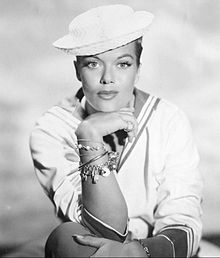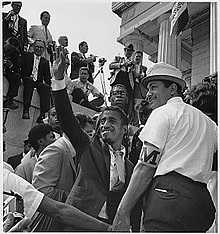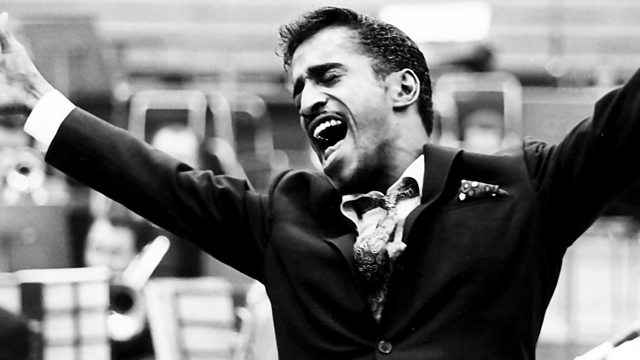
Davis
Born December 8, 1925 in the Harlem section of New York City to a pair of entertainers (stage performer and entertainer Sammy Davis Sr. and Afro-Cuban tap dancer Elvera Sanchez), Davis is a performer by age three, when his parents divorce, and not wanting to lose custody of his son, his father takes him on the road and quickly works him into his act.as part of the Will Mastin Trio (and knowing the part the men play in his life, also sheltering him from bigotry until he is in the Army during WWII, includes them in his bookings for the rest of his career ... all three men are buried next to each other in the Davis Family tomb). A Shirley Temple type child sensation, at only seven-years-old, Davis stars in the title role of the film, Rufus Jones for President, a role that lets him sing and dance with the legendary Ethel Waters.

As Rufus

Senior, Junior, And Mastin
A member of an integrated Special Services unit responsible for entertaining troops during WWII, when the war concludes, Davis rejoins the Will Mastin Trio, and using the pseudonyms Shorty Muggins and Charlie Green, records blues songs for Capitol Records. He becomes a major star, one both black and white audiences love when the trio is booked to be the opening act for singer Janis Paige at the West Hollywood, California nightclub, Ciro's on March 23, 1951 (located on the famous Sunset Blvd.). Allotted only twenty minutes to perform, the star filled venue goes nuts for the dancing and Davis' impressions, and the group performs for almost an hour ... and in a legendary moment of Hollywood magnanimity, Paige gives the group top billing and she becomes their opening act. Making many star friends and mixing group performances with going solo, Davis garners praise from audiences and critics ... and appears well on his way to becoming a huge sensation nationwide ... until he almost loses his life, and then vision, on a cold November morning in the high deserts of California.

Janis Paige

Ciro's
Returning to Los Angeles from Las Vegas (and a gig at the Frontier Hotel), accompanied by valet Charlie Head (who drives the first leg of the journey to Victorville where a stop is made for gas), 28-year-old entertainer Sammy Davis Jr. is at the wheel of a shiny new black Cadillac at 7:00 in the morning when he drives down Cajon Pass and reaches a fork in U.S. Route 66 in San Bernadino, California (at Cajon and Kendall Drives) that is unfortunately already occupied by a Chrysler driven by 72-year-old Helen Boss, accompanied by her friend, 69-year-old Bessie Ross ... missing the turn, Boss is in the process of correcting her error, backing into the intersection, when Davis arrives. Slow-motion fast, unable to react in time, the Cadillac crashes into the rear of the Chrysler, careens off, barely avoiding on coming traffic, and finally stops when it plows into a stone column at the entrance of a nearby driveway ... and then the damage assessments begin. Both occupants of the Chrysler will survive the encounter ... Boss severely injures her back, while Ross suffers a broken leg. The injures are much worse for the men in the Cadillac. Sleeping in the back seat, Head is thrown violently against the steel-framed front seat and fractures his jaw and loses all of his teeth, while Davis has his face driven into the car's steering wheel and front dashboard, breaking his knee cap on the Cadillac emergency brake, fracturing his nose on the sun visor, and horrifically, having his left eye make a direct hit on the bullet-shaped horn button of the wheel that is a standard feature of the 1954 and 1955 models of the car, a collision within the collision that forces the entertainer's left eye out of it's socket (engine pushed back into the front seat area, Davis survives being crushed to death only by his slight build).

1954 Black Cadillac
Ambulance rides for all, Davis and Head are whisked away to first the San Bernardino County Hospital, and then transferred to the San Bernardino Community Hospital when it is deemed a better venue for treating the men's injuries, but the process takes six long hours (there will be rumors of racism being involved, but Davis himself will have none of it). Injuries patched up and deemed survivable, San Bernardino eye-surgeon, Dr. Frederick H. Hull is powerless however in saving Davis' left eye (the right eye is saved though, and Hull also attaches a prosthetic socket on to the eye muscles that will allow Davis to control the glass eye he will later wear the rest of his life ... in the immediate aftermath of the accident, for the next six months he will wear a black eye patch over the wounded socket). Healing process begun, at the hospital, Davis will be visited by Hollywood friends, actor Jeff Chandler (who offers to give up an eye if it will prevent Davis from suffering total blindness), star-couple Tony Curtis and Janet Leigh, Eddie Cantor, and Frank Sinatra (released on Sunday, November 28th, he will mend at the Palm Springs home of Mr. Sinatra ... as it will one day be reported by a Davis friend, "... you just don't say no to Frank.").

Cantor

With Tony Curtis And Jeff Chandler
Back On Stage With His Family
Reflecting on how lucky he is to be alive (the entertainer will consider the collision the turning point of his career), Davis realizes he has forgotten to wear o the night of the accident for the first time since receiving it the year before, his personal good luck charm ... a gift mezuzah (usually hung in the doorways of Jewish homes) from Jewish comedian Eddie Cantor. And discussing the gift later, Davis enters into conversations with Cantor that eventually lead to the entertainer converting to the Judaism in 1961 (he had been born of a Catholic mother and Protestant father).

Doorway Mezuzah
Impressed by the service he receives at the hospital, Davis vows to perform a benefit concert for the hospital when he is fully recovered ... and does so on November 15, 1958, at the 7,500 seat Swing Auditorium at the National Orange Show Events Center (the concert of course sells out) ... a star studded event in which Davis sings and dances, and is joined by Judy Garland (who does eight songs, including her signature tune, Somewhere Over The Rainbow), James Garner, Sidney Poitier, Danny Thomas, and Shirley MacLaine, that gains the hospital over $20,000! Onward and upward, the performer graces the world of entertainment with his smiles and talents for thirty-eight more years (he eventually dies in Beverly Hills, California at the age of 64 as a result of throat cancer) ... thirty-eight years that include singing the title song in 1954's Universal picture, Six Bridges to Cross, starring on Broadway in 1956's Mr. Wonderful, becoming a member of the legendary Rat Pack in 1959 (with fellow performers Frank Sinatra, Dean Martin, Joey Bishop, and Peter Lawford ... a name given the group by actress Angie Dickinson after seeing them in the morning after a long night of drunken poker), roles in movies and on TV (in a famous TV moment, he will kiss Archie Bunker on All In The Family, headlining at the Frontier Casino in Las Vegas, starring on Broadway in Golden Boy in 1964, scoring a 1972 #1 hit with The Candy Man, singing the theme song to the TV hit, Baretta (Keep Your Eye On The Sparrow), becomes a buddy of Elvis Presley, makes a cameo performance in the James Bond movie, Diamonds Are Forever, appears on the daytime soap opera, One Life To Live, takes photographs that will be published in a 2007 book, becomes a gun enthusiast who competes in quick draw events, works benefit concerts and telethons for numerous worthy charities and causes, and works hand-in-hand with numerous legendary civil rights leaders on ending racial segregation in the United States (he switches from being a Democrat to a Republican when afraid of how his presence might look, he is banned from the White House by former friend, JFK ... who also drops Frank Sinatra around the same time). And he also finds time to marry three women (black dancer Loray White in 1958, white Swedish-born actress May Britt in 1960, and black dancer Altovise Gore in 1970) and have four children (one daughter, and three adopted sons) ... and be honored with a Lifetime Achievement Grammy (along with four Grammy nominations), win an Emmy award (and garner another four nominations), win the 1989 NAACP Image Award, be nominated for a Tony award (for 1965's Golden Boy), get a star on the Hollywood Walk of Fame (why only one?), be nominated for a Golden Globe, and be a Kennedy Center honoree in 1987
The Rat Pack

At The March On Washington - 1963

Singing In Robin and The Seven Hoods
With Martin Luther King Jr.
Breaking The Taboo Of Interracial Marriage

Oval Room Visit - 1973
A cultural icon, Davis has his crossroads moment on this day in 1954.

Davis
No comments:
Post a Comment